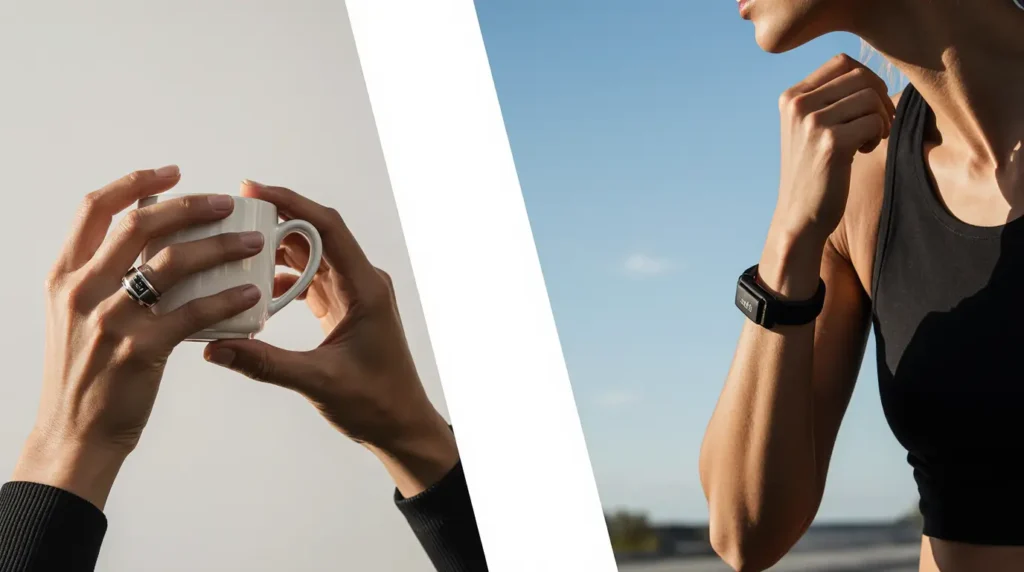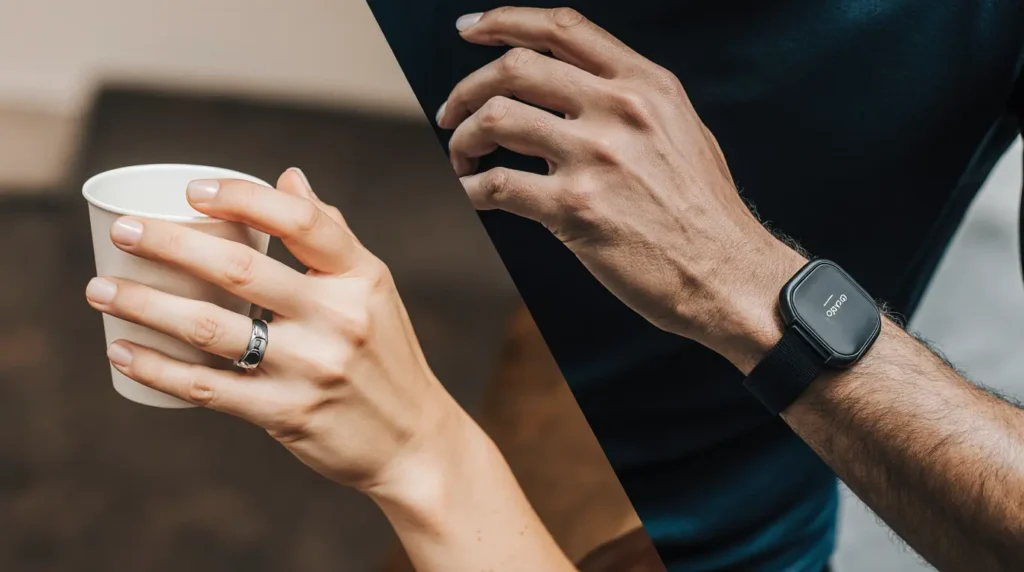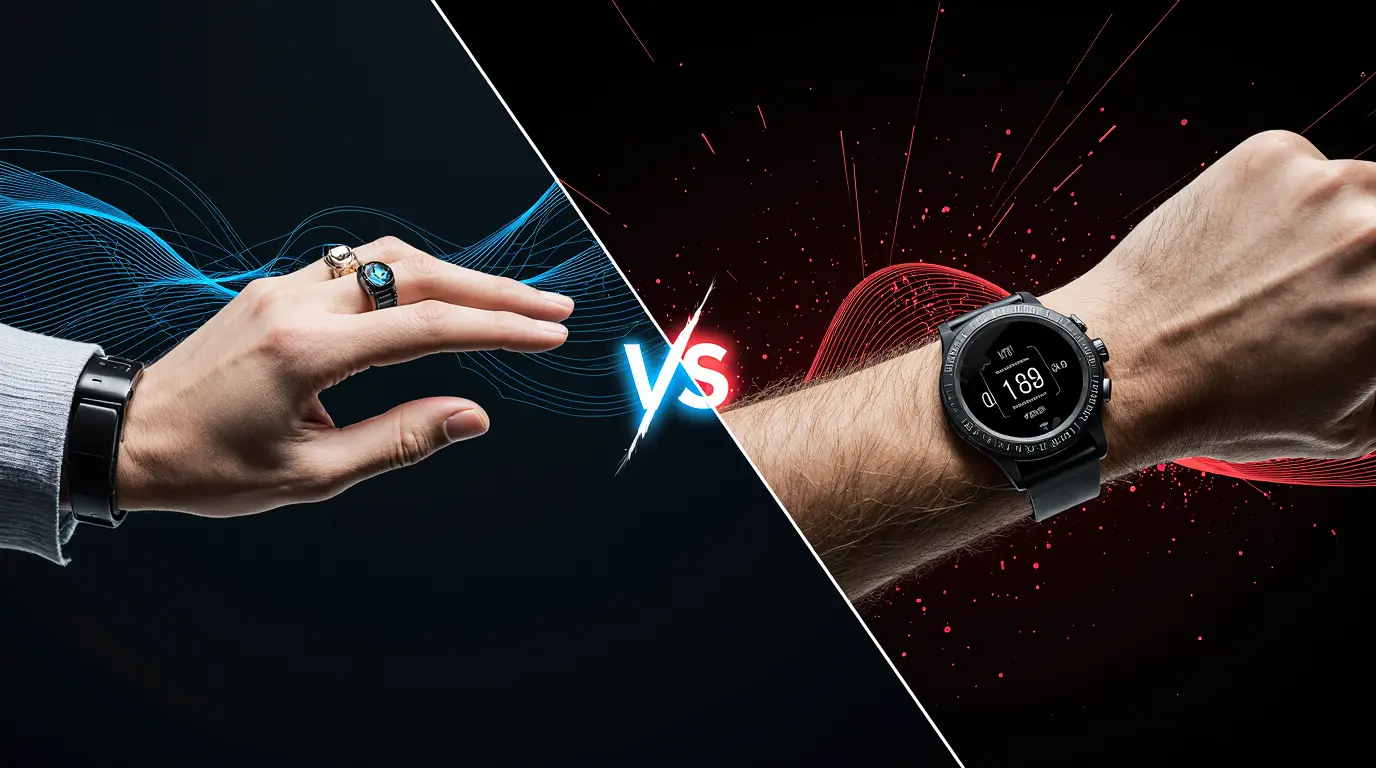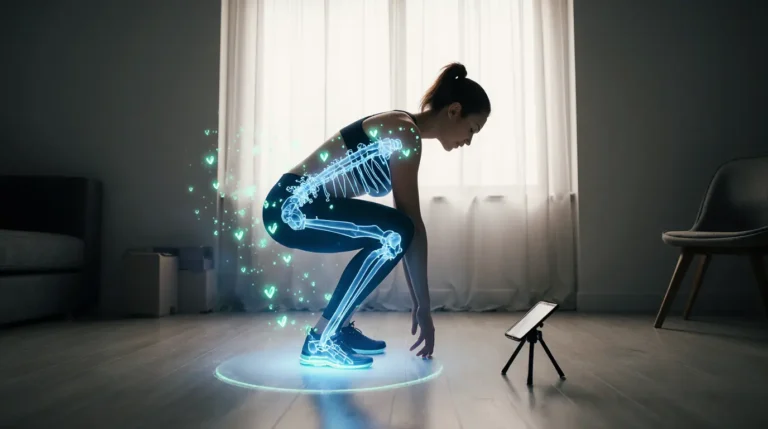Oura Ring vs Whoop: The Ultimate Recovery Tracker Battle for 2025
In the rapidly evolving world of wearable health technology, two names consistently rise to the top: Oura and Whoop. Both promise to decode your body’s signals, optimize your sleep, and supercharge your recovery using sophisticated AI. But while their goal is similar, their philosophies and form factors are worlds apart. This creates a difficult choice for anyone serious about their health. So, in the ultimate Oura Ring vs Whoop showdown, which device truly deserves a place on your body? This in-depth comparison will break down every detail to help you decide. This is a critical topic within our The Ultimate Guide to AI for Wellness.
Oura Ring vs Whoop: A Quick Comparison Table
| Feature | Oura Ring Gen3 | Whoop 4.0 |
|---|---|---|
| Form Factor | Discreet Ring | Athletic Wristband |
| Primary Focus | Sleep & Readiness | Strain & Recovery |
| Key Metrics | Readiness, Sleep, Activity | Strain, Recovery, Sleep |
| Subscription | Required for full features | Required for everything |
| Best For | Health-conscious individuals | Dedicated athletes |
| Battery Life | 4-7 days | 4-5 days |
| Unique Feature | Period Prediction | Strain Coach, Any-Wear™ Tech |
Deep Dive: The Oura Ring Gen3

Design and Form Factor:
The Oura Ring’s greatest strength is its subtlety. It functions as a high-performance health monitor but is artfully designed to look like a piece of minimalist jewelry. Crafted from lightweight titanium, it’s meant for constant wear without attracting notice. For professionals, minimalists, or anyone averse to wearing a plastic band, the Oura Ring is in a league of its own. You could wear it to a business meeting or a wedding, and it would simply be seen as a stylish ring, not a device tracking your heart rate variability.
Key Features and Metrics Oura revolves around three simple scores:
Readiness, Sleep, and Activity. The Readiness score is its centerpiece, a daily number from 0-100 that tells you how prepared your body is for the day’s challenges. It’s calculated using your resting heart rate, HRV, body temperature, and recent sleep performance. Oura is particularly renowned for its highly accurate sleep tracking and its advanced temperature sensors, which provide sensitive insights into health trends and menstrual cycle prediction.
Who is the Oura Ring Best For?
The Oura Ring is ideal for the health-conscious individual whose primary goal is to understand and improve their sleep and overall well-being. It’s for the person who wants deep physiological insights without broadcasting to the world that they are tracking their data. If your main priorities are sleep quality, stress management (via HRV), and illness detection, the Oura Ring is arguably the best recovery tracker for you.
Deep Dive: The Whoop 4.0

Design and Form Factor:
The Athletic Band Whoop makes no attempt to hide what it is: a dedicated performance and recovery tool. It’s a screenless, fabric band designed for athletes. Its unique feature is the Any-Wear™ technology, which allows you to remove the sensor pod from the wristband and place it in specially designed apparel like sports bras or compression shorts, enabling more accurate tracking during contact sports.
Key Features and Metrics Whoop’s ecosystem is built on three pillars:
Strain, Recovery, and Sleep. The Strain score is its defining feature. It quantifies the total cardiovascular load your body endures throughout the day, from workouts to daily stress. The AI-powered Strain Coach gives you real-time recommendations on how much further you should push to reach your desired training state (e.g., optimal, restorative). The Recovery score, like Oura’s Readiness, uses HRV, RHR, and sleep data to tell you how prepared you are for that strain.
Who is Whoop Best For?
Whoop is built for the dedicated athlete and the data-obsessed biohacker. If your life revolves around training cycles, optimizing performance, and balancing intense workouts with strategic recovery, Whoop is your device. The Strain Coach is a powerful AI fitness coach that provides a level of daily training guidance Oura doesn’t offer. If your primary question is “How hard should I train today?” then Whoop is the answer.
Head-to-Head Battle: Key Differences
This head-to-head battle is the core of our Oura Ring vs Whoop analysis.
Data Accuracy: A Key Factor in the Oura Ring vs Whoop Debate
Both devices are highly respected for their accuracy, particularly in measuring heart rate and HRV. Independent studies, such as those conducted by The Quantified Scientist on YouTube, have shown that both Oura and Whoop are among the most accurate consumer wearables, often rivaling chest straps for heart rate data during sleep. For basic trends, both are excellent.
Sleep Tracking Analysis:
Who Owns the Night? This is a close fight, but Oura often gets the edge. Both devices provide detailed sleep stage analysis. However, Oura’s integration of body temperature provides an extra layer of data that many users find gives it a more sensitive and accurate sleep analysis. To understand these metrics better, check out our guide to unlocking better sleep with AI.
Activity and Strain Tracking:
For the serious athlete, Whoop holds a distinct advantage. Its entire philosophy is built around balancing Strain and Recovery. The Strain Coach is a game-changing feature that Oura lacks, making it a far more powerful tool for anyone following a structured training plan, as described in our AI personal trainer guide.
The App Experience and AI Coaching
In the Oura Ring vs. Whoop comparison, the app experience is a crucial battleground where their distinct identities become clear. The two apps share a commitment to a high-quality user experience, but their approaches to data presentation and user interaction diverge significantly. Oura is designed for passive reflection on your well-being, whereas Whoop is engineered for proactive engagement with your performance data. Whoop also features a more advanced AI Coach powered by GPT-4, allowing you to ask nuanced questions about your metrics in plain language. Ultimately, both platforms revolve around interpreting Heart Rate Variability, but they package and present it in unique ways.
Pricing Model: Subscription vs. Hardware This is a major deciding factor.
Perhaps the biggest difference when deciding between the Oura Ring vs Whoop is their pricing model.
- Oura: You purchase the ring itself (starting at $299 USD), then pay a monthly subscription ($5.99/month).
- Whoop: The hardware is “free” with a subscription (typically starting around $30/month, with longer commitments reducing the monthly cost). Over two years, the cost of Whoop is significantly higher.
The Final Verdict: Which One Should You Buy?
There is no single “winner” in the Oura Ring vs Whoop debate—only the right choice for a specific type of person.
- You should buy the Oura Ring if: You are a health-conscious individual who prioritizes sleep, stress management, and overall well-being.
- You should buy Whoop if: You are a dedicated athlete or fitness enthusiast whose life is structured around training.
Answering that question will tell you which of these incredible AI recovery coaches belongs on your body. As the technology evolves, we’ll be sure to cover [Beyond Oura and Whoop: The Next Generation of Biosensors].
Frequently Asked Questions (FAQ)
Can I wear both Oura and Whoop at the same time?
Can I wear both Oura and Whoop at the same time? Yes, many data enthusiasts do, but it’s an expensive option.
Do I need a subscription for both?
Yes. To get the full functionality from either device, a paid monthly subscription is mandatory.
Which one is better forIn the Oura Ring vs Whoop battle, which one is better for strength training?strength training?
Whoop is generally considered better for strength training due to its Strain algorithm and versatile form factor.








4 Comments